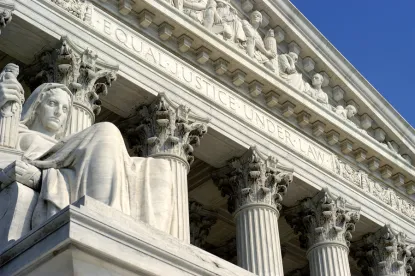Two weeks remain before the Supreme Court hears oral arguments in Kisor v. Wilkie, a likely landmark case for energy and infrastructure companies. When the Supreme Court granted certiorari in December 2018, it took the case specifically to decide whether to overturn Auer v. Robbins1, which holds that courts should defer to an agency’s interpretation of its own regulations. This Energy Legal Blog® post kicks off a short series about Kiso rand Auer’s significance for developers of energy and non-energy infrastructure. Write-ups on these cases are plentiful, but our perspective is different. Our posts will focus on how the Court’s decision may affect companies and projects in tangible ways, while explaining the administrative law niceties as we go along.
Why Care About Auer?
We’ll start with why the (in)validity of Auer matters. Briefly put, major infrastructure projects—think pipelines, transmission lines, highways, ports, LNG facilities, etc.—require numerous federal authorizations and reviews, all of which entail applying agency doctrine concerning regulations. Under Auer, differences of regulatory interpretation resolve in favor of the agency. This can be crucial to defending federal permits when they are challenged in court by opponents of development. In such litigation, the developer rows shoulder to shoulder with the challenged agencies to defend the permits, pulled along in Auer’s current. Not so when an agency withholds or conditions a permit based on a new or aggressive regulatory interpretation. There, the developer rows alone against the Auer current.
The tidal pull of Auer deference—sometimes lifting the boat, sometimes beaching it—invites comparison to Chevron2 deference. Under Chevron, courts will defer to an agency’s interpretation of the statute it administers when the statutory text is ambiguous and the agency’s construction of the statute is permissible. But Auer, whose headwaters in Bowles v. Seminole Rock3 predate the Administrative Procedure Act of 1946 (“APA”)4, directs courts to accept an agency’s interpretation of ambiguous regulations where the interpretation is not plainly erroneous or inconsistent with the regulations. Auer has buoyed interpretations even when they were first asserted after the fact, in private, or in explanatory documents created after litigation over the interpretation had already commenced. Both Auer deference and Chevron deference are creatures of judicial doctrine that could be modified or struck.
What Is Mr. Kisor Upset About?
The Supreme Court granted certiorari in Kisor v. Wilkie to address the continued merits of Auer head on. The case arose out of James Kisor’s service in Vietnam and focuses on his disability benefits for post-traumatic stress disorder, or PTSD. His request for more benefits turns on whether Mr. Kisor’s combat service records are “relevant” to the diagnosis of PTSD, where “relevance” is a term left unaddressed in the regulations. In 1982, after service in the Vietnam War, Mr. Kisor sought disability benefits from the U.S. Department of Veterans Affairs (“VA”) for PTSD. The VA denied PTSD-related benefits as diagnoses showed a personality disorder, and they did not review his combat service records in denying the claim. When Mr. Kisor petitioned for PTSD benefits in 2006, the VA recognized Mr. Kisor’s PTSD and began to provide disability benefits starting immediately but did not provide PTSD-related disability for the period between 1982 and 2006. Under VA regulations, a veteran may receive back-pay for benefits when relevant records were possessed but not reviewed by the VA when an original disability claim is made. Mr. Kisor argues that his combat service records, in possession and unreviewed by the VA in 1982, are relevant to his PTSD diagnosis. But the VA says that only psychiatric evaluations are relevant to such diagnoses, and the federal courts have expressly upheld the VA’s interpretation relying on the Auer principle of deference to agency interpretations. Mr. Kisor has challenged the use of Auer deference directly, and the Supreme Court has decided to review whether Auer is sound – or was soundly applied.
Facts aside, the essence of Mr. Kisor’s concern should resonate with energy and infrastructure companies. When should an agency be allowed to limit a benefit (or impose a condition or withhold a permit) based on a picayune interpretation of an undefined but significant word in its own regulations? If VA can exclude wartime service records as not “relevant” to wartime PTSD, how broad may be another agency’s latitude in interpreting its permitting regulations?
How the Arguments Are Shaping Up
Mr. Kisor argues that Seminole Rock and Auer were poorly considered—indeed, the Court in Seminole Rockannounced the deference principle without any constitutional justification. The petitioner also argues that the APA, passed the year after Seminole Rock, requires procedural safeguards for notice-and-comment rulemaking and that the Auer principle is inconsistent with such goals. Some justifications for Chevron deference—for example, that Congress left passages vague because it knew an expert agency would fill the gaps—do not apply when the expert agency wrote the rule to begin with. And Auer has led to excesses, Mr. Kisor argues, because federal courts have deferred to agency interpretations no matter when offered and no matter how much the agency may be biased towards a particular outcome. Moreover, agency interpretations can shift, sometimes dramatically, when a new administration is elected, even though the regulations remain unchanged. And because agencies are often interested parties in particular outcomes and exercise rulemaking and adjudicative functions, Mr. Kisor argues that Auer is inconsistent with bedrock constitutional principles like separation of powers . . .
. . . and for the most part, the government agrees! Although the government opposed Mr. Kisor’s certiorari petition, it has modified its approach in briefing. It agrees that Auer has been used inappropriately, often to prop up post hoc justifications of agency interpretations. But instead of overruling Auer, the government wants to rehabilitate it by narrowing it and asking the Court to supply a principled basis as it did in Chevron and U.S. v. Mead Corp.5 First, courts should use all the tools of statutory interpretation to confirm that an agency’s interpretation is reasonable. The government argues that courts have been far too lax in this primary duty to “say what the law is.”6 Second, if the interpretation is found reasonable, courts should defer only when it was issued with fair notice, is not inconsistent with an agency’s prior views, rests on an agency’s expertise, and expresses the considered view of the agency and not low-level employees. This two-step rubric, the government contends, preserves the reliance interest in numerous Auer-based decisions and promotes political accountability and respect for agency expertise.7
What’s Next?
Oral arguments in Kisor are set for March 27, and from the briefing so far we may be looking at a very different administrative law regime when the Supreme Court’s opinion is issued. Over 25 amici briefs have been filed and more are sure to come. Whatever the outcome, please visit us again as we break down the oral arguments and later when the Court issues its opinion.
1 519 U.S. 452 (1997).
2 467 U.S. 837 (1984).
3 325 U.S. 410 (1945).
4 5 U.S.C. § 551 et seq.
5 533 U.S. 218 (2001).
6 Marbury v. Madison, 5 U.S. 137 (1803).
7 Under these principles, the government argues the VA properly applied its interpretation in Mr. Kisor’s case, and that its decision should be upheld.





 />i
/>i
